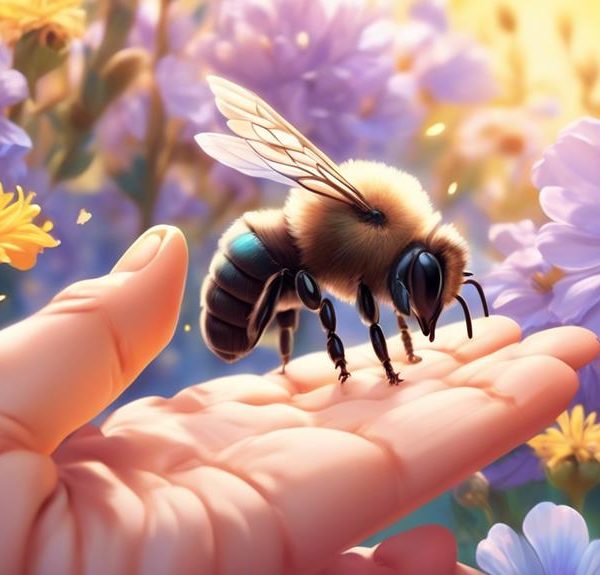Take a journey to discover the surprising presence and profound role of Mason bees in East Texas Tyler's ecosystem.

Are Mason Bees Found in East Texas Tyler
Just as Sherlock Holmes unraveled the mysteries of London, you're about to embark on a journey to discover the secrets of East Texas Tyler's ecosystem.
Have you ever wondered about the presence of Mason bees in this region? Known as nature's best-kept secret, these unassuming pollinators are often overshadowed by their more famous relatives, the honeybees. Yet, their impact on the environment is just as profound, if not more so.
As we explore this topic, you'll start to question the often overlooked intricacies of our natural world and perhaps, you'll find yourself more invested in the fate of these industrious creatures.
Key Takeaways
- Mason Bees are solitary insects that build their own nests and lay eggs.
- They are exceptional pollinators, with a single Mason Bee able to pollinate what it takes 100 honeybees to do.
- Mason Bees thrive in regions with cool winters and warm springs, like East Texas Tyler, and are attracted to gardens with a variety of flowering plants.
- Mason Bees play a crucial role in pollinating commercial crops, contribute to plant diversity, and foster a thriving environment.
Understanding Mason Bees
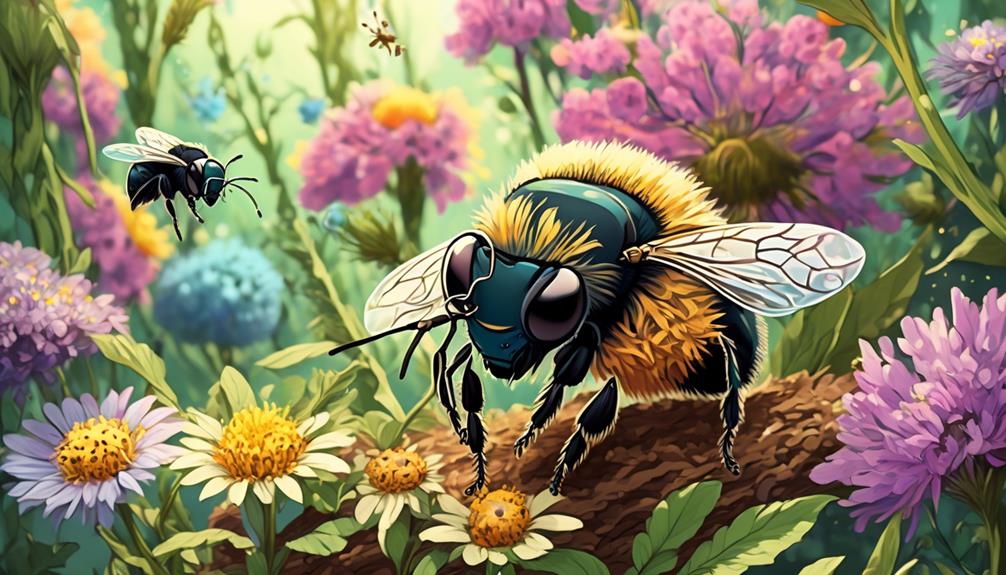
To truly appreciate the presence of Mason Bees in East Texas Tyler, it's critical to delve into their unique characteristics, life cycle, and the pivotal role they play in our ecosystem.
You'll find these bees fascinating due to their solitary nature. Unlike honeybees, they don't live in colonies. Each female is a queen, building her own nest and laying eggs.
These industrious insects seek out small cavities like hollow stems or holes in wood for nesting. They'll stuff each compartment with pollen and nectar before laying a single egg and sealing it off with mud – hence the name 'Mason'.
Their life cycle is a year-long process, beginning as an egg in spring, maturing into a larva by summer, and becoming an adult bee that hibernates for winter.
Their role in our ecosystem is indispensable. They're among the first bees to emerge in spring, making them essential pollinators of early-blooming plants. Despite their solitary nature, they're non-aggressive and rarely sting.
Mason Bees' Habits and Habitat
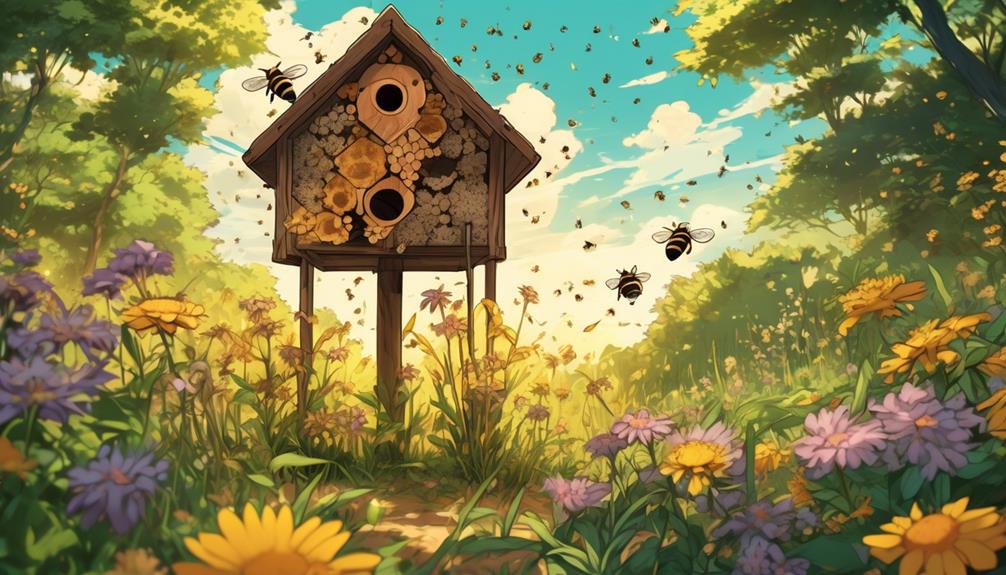
Now that you're familiar with the unique life cycle and vital role of Mason Bees in our ecosystem, let's explore their intriguing habits and the specific environments they prefer.
Unlike honeybees, Mason Bees are solitary creatures. They don't live in hives but in individual tubes or holes. You'll find them nesting in natural cavities like hollow stems, woodpecker drillings, or even the ground.
Mason Bees are named for their masonry-like behavior. They use mud to build partitions and seal their nests. These hardworking bees are also exceptional pollinators. In fact, a single Mason Bee can pollinate what it takes 100 honeybees to do!
Despite their industrious nature, they're non-aggressive and only sting when threatened. They thrive in a variety of climates, but prefer regions with cool winters and warm springs, like East Texas Tyler.
They're attracted to gardens with a variety of flowering plants. Providing a bee house with small tubes or holes can invite Mason Bees to your garden, enhancing pollination and increasing the biodiversity of your local ecosystem.
East Texas Tyler's Flora and Fauna
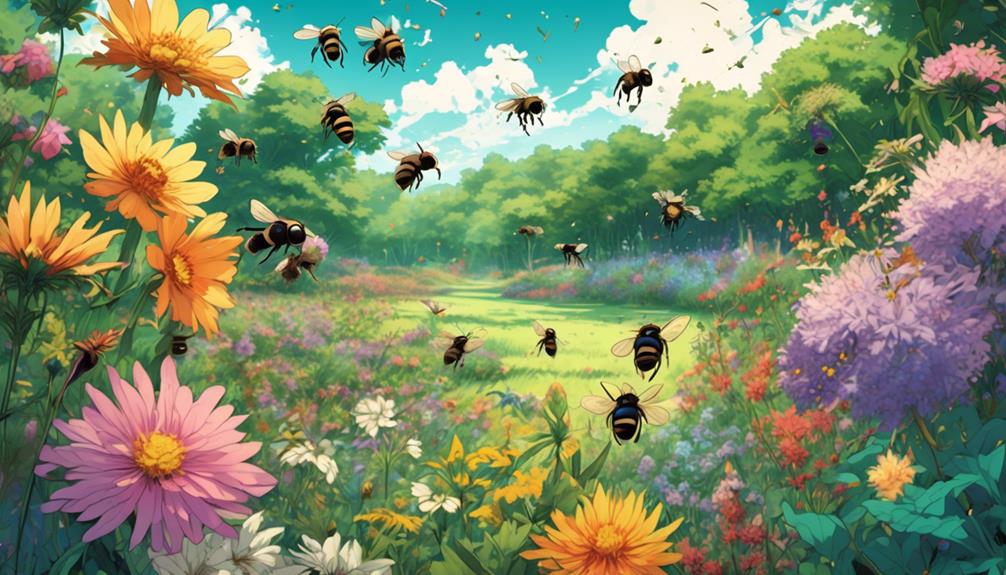
Diving into the rich biodiversity of East Texas Tyler, you'd discover a stunning array of flora and fauna that not only supports the local Mason Bee population but also contributes to a lively, thriving ecosystem.
The region's lush woodland and prairie landscapes are home to a variety of plant species such as the Piney Woods Hibiscus, the Texas Bluebonnet, and the Swamp Sunflower, each offering nectar and pollen that Mason Bees relish.
In addition to the greenery, numerous animal species coexist in these habitats. You'll spot creatures like the Red Fox, White-tailed Deer, and the Eastern Wild Turkey. But it's in the bird population where you'll notice another ally of the Mason Bee – the Ruby-throated Hummingbird. Its pollination behavior aids in the dispersion of nectar and pollen, promoting plant reproduction.
Aquatic ecosystems are also abundant, hosting species like the Texas Blind Salamander and the Alligator Gar. These habitats, too, play a role in supporting the Mason Bees, providing water sources and damp soil for their nesting.
Mason Bees in East Texas Context
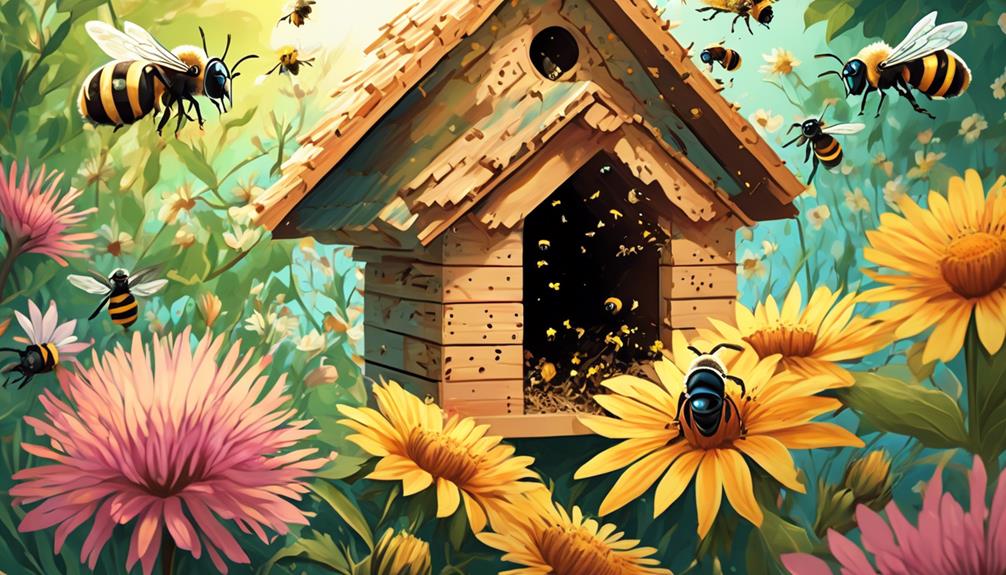
Exploring the world of Mason Bees in the East Texas context, you'd find these industrious pollinators making the most of the region's diverse flora and fauna, establishing their nests in pre-existing cavities and thriving on the nectar and pollen from local plant species. They're a crucial part of the ecosystem, working hard to pollinate the plants around them, and contributing significantly to the biodiversity of the region.
Let's visualize their habitat and behavior through this table:
Habitat | Behavior | Contribution |
|---|---|---|
Pre-existing cavities | Industrious pollinators | Enhance biodiversity |
Local plant species | Thrive on nectar and pollen | Pollinate plants |
Diverse flora and fauna | Build nests | Balance ecosystem |
East Texas region | Adaptable to environment | Support local agriculture |
Various ecosystems | Solitary lifestyle | Non-aggressive nature |
Understanding the role of Mason Bees in a local context helps us appreciate their significance and the need to protect them. They're a gentle species, rarely stinging unless threatened. As solitary bees, they don't produce honey or wax, but their efficiency in pollination makes them an invaluable part of our environment. So, next time you spot one, remember, they're doing their part for the East Texas ecosystem.
Verifying Mason Bees' Presence
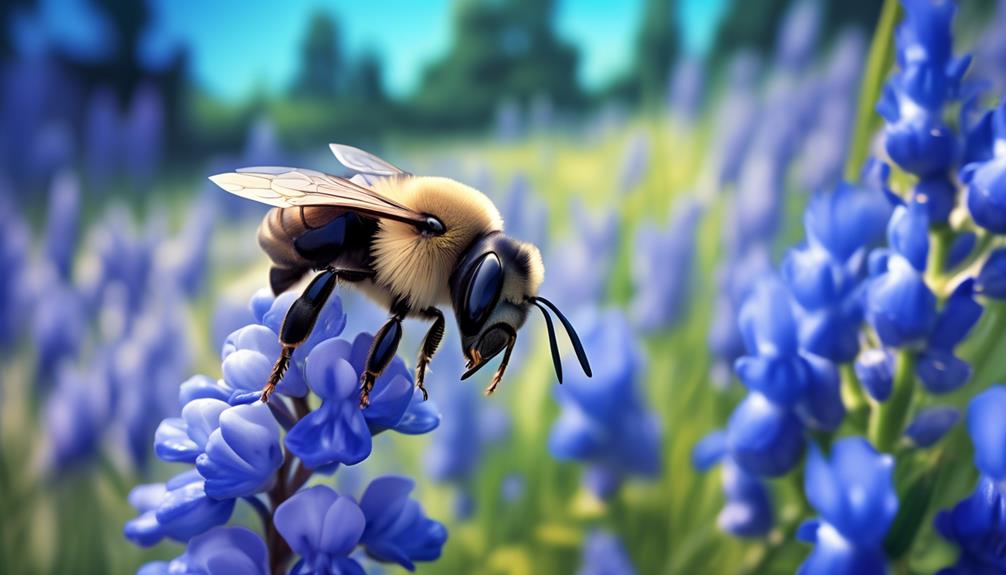
While appreciating the significant role of Mason Bees in East Texas, it's equally important to verify their presence in the area, ensuring that these diligent pollinators are indeed prospering in their local habitats. As you embark on this fascinating endeavour, you'll need to know what to look for.
Mason Bees are solitary insects, so don't expect to find large hives like those of their honeybee relatives. Instead, focus your search on holes in wood or hollow stems where females lay their eggs. These bees use mud to seal each egg within its own chamber, hence the name 'Mason'.
Another key identifier is their unique blue-black coloration. Unlike the common honeybee's distinctive yellow and black stripes, Mason Bees possess a metallic sheen that can aid in their identification.
In addition, Mason Bees are active pollinators during the spring. You'll often find them buzzing around flowering plants, collecting pollen and nectar. So, if you spot small, shiny, blue-black bees around your garden during this season, it's a good sign that Mason Bees are in your area.
Impact of Mason Bees on Local Ecosystem
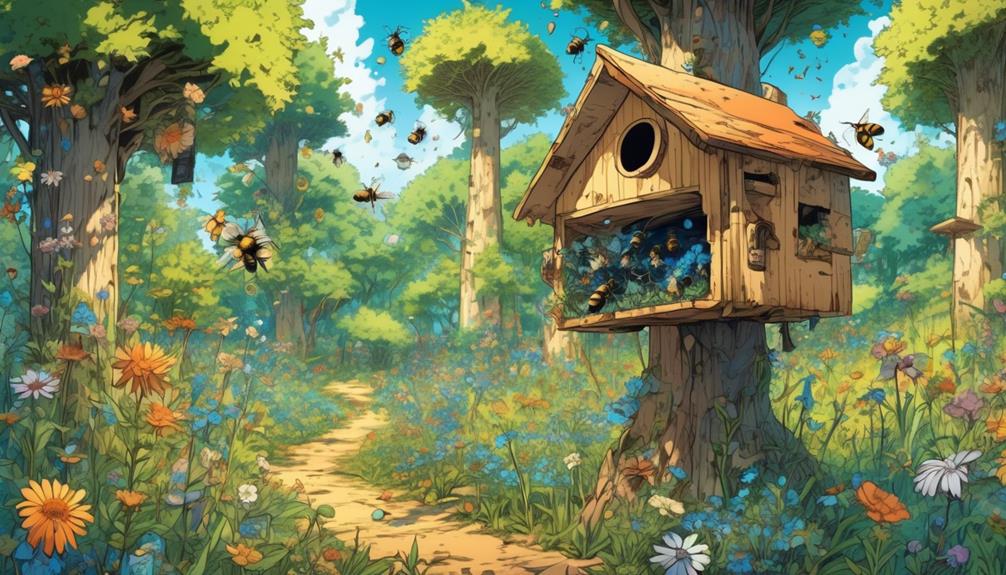
You mightn't realize it, but Mason Bees play a crucial role in maintaining the health and diversity of the local ecosystem in East Texas. These mighty insects are top-notch pollinators, outperforming even the revered honeybee. They're drawn to a variety of local flora, which boosts plant diversity and fosters a thriving environment.
Mason Bees are solitary bees, meaning they don't live in large colonies like honeybees. Each female lays her eggs in individual chambers with each chamber containing a food store. This solitary nature reduces the spread of disease, thus enhancing their survival rate.
These bees also contribute to the local economy. They're instrumental in pollinating commercial crops, particularly fruit trees. Without them, the yield of these crops would significantly drop, impacting the food supply chain.
Moreover, Mason Bees play a part in nutrient cycling. As they forage, they inadvertently move bits of organic matter, aiding in decomposition and soil health. They're crucial to maintaining the balance of the ecosystem, enhancing its resilience.
Frequently Asked Questions
What Are Some Common Predators of Mason Bees in East Texas Tyler?
You're curious about the predators of mason bees in East Texas Tyler. These bees face threats from various critters.
Birds, spiders, wasps are all common predators, but they also must contend with parasitic insects like the cuckoo bee. Some insects lay their eggs in mason bee nests, and their larvae consume the mason bee larvae.
Additionally, fungal diseases and pesticides can also threaten these diligent pollinators.
How Can One Differentiate Mason Bees From Other Bee Species in East Texas Tyler?
Yes, you can differentiate Mason bees from others in East Texas Tyler by observing their size, color, and behavior. They're smaller than honeybees, often metallic blue or green.
Unlike honeybees, they're solitary, meaning they don't live in hives. Also, they're named for their habit of using mud to build their nests.
Check out their unique nesting habits, you'll see it's quite different from other bee species.
What Are Some Local Initiatives or Programs in East Texas Tyler Aimed at Protecting Mason Bees?
Yes, there are several initiatives in East Texas, Tyler, focused on protecting Mason Bees.
You'd find local garden clubs and schools participating in bee conservation programs. They're creating bee-friendly habitats and educating others about their importance.
The Texas Beekeepers Association also provides resources and support.
How Can Residents of East Texas Tyler Contribute to the Conservation of Mason Bees?
You can contribute to mason bee conservation in East Texas Tyler in several ways.
- You could plant native flowering plants in your garden to provide food.
- You can also build bee houses for shelter.
- Avoiding pesticides is crucial too, as they're harmful to bees.
- Participating in local conservation programs is another great way.
Are There Any Specific Diseases or Parasites That Affect Mason Bees in East Texas Tyler?
Yes, there are specific diseases and parasites that plague Mason bees in East Texas. You'll often find the chalkbrood fungus and the varroa mite, a parasite that's lethal to these bees.
You'll also see parasitic wasps, which lay their eggs in Mason bee larvae.
It's vital you monitor your bee populations for these threats, and take action if you spot them.
It's a tough job, but it's key for the bees' survival.
Conclusion
So, you've discovered that Mason bees indeed inhabit East Texas Tyler. They're an integral part of the local ecosystem, pollinating various flowers and contributing to biodiversity.
Their presence speaks volumes about the health and richness of the local flora and fauna. Remember, they're not a threat but a boon, helping to keep the environment thriving.
So, next time you spot a Mason bee, appreciate its role in maintaining the delicate balance of nature.


